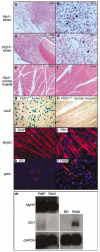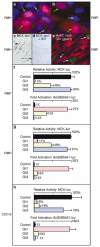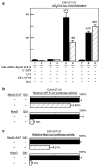The hedgehog regulated oncogenes Gli1 and Gli2 block myoblast differentiation by inhibiting MyoD-mediated transcriptional activation
- PMID: 16964293
- PMCID: PMC3325095
- DOI: 10.1038/sj.onc.1209891
The hedgehog regulated oncogenes Gli1 and Gli2 block myoblast differentiation by inhibiting MyoD-mediated transcriptional activation
Abstract
The mechanism by which activation of the Hedgehog (Hh) pathway modulates differentiation and promotes oncogenesis in specific tissues is poorly understood. We therefore, analysed rhabdomyosarcomas from mice that were haploinsufficient for the Hh-binding protein, Hip1, or for the Hh receptor, Patched 1 (Ptch1). Transfection of the Hh-regulated transcription factor Gli1, which is expressed in a subset of mouse and human rhabdomyosarcomas, suppressed differentiation of myogenic rhabdomyosarcoma lines generated from Hip1+/- and Ptch1+/- mice. The closely related factor, Gli2, had similar effects. Gli1 and Gli2 inhibited myogenesis by repressing the capacity of MyoD to activate transcription. Deletion analysis of Gli1 indicated that multiple domains of Gli1 are required for efficient inhibition of MyoD. Gli1 reduced the ability of MyoD to heterodimerize with E12 and bind DNA, providing one mechanism whereby the Gli proteins modulate the activity of MyoD. This novel activity of Gli proteins provides new insights into how Hh signaling modulates terminal differentiation through inhibition of tissue-specific factors such as MyoD. This mechanism may contribute to the broad role of Hh signaling and the Gli proteins in differentiation decisions and cancer formation.
Figures







Similar articles
-
HEDGEHOG/GLI-E2F1 axis modulates iASPP expression and function and regulates melanoma cell growth.Cell Death Differ. 2015 Dec;22(12):2006-19. doi: 10.1038/cdd.2015.56. Epub 2015 May 29. Cell Death Differ. 2015. PMID: 26024388 Free PMC article.
-
Unique and complimentary activities of the Gli transcription factors in Hedgehog signaling.Exp Cell Res. 2006 Jul 1;312(11):1925-38. doi: 10.1016/j.yexcr.2006.02.019. Epub 2006 Mar 29. Exp Cell Res. 2006. PMID: 16571352
-
Control of somite patterning by Sonic hedgehog and its downstream signal response genes.Development. 1998 Feb;125(4):777-90. doi: 10.1242/dev.125.4.777. Development. 1998. PMID: 9435297
-
The sonic hedgehog-patched-gli pathway in human development and disease.Am J Hum Genet. 2000 Nov;67(5):1047-54. doi: 10.1016/S0002-9297(07)62934-6. Epub 2000 Sep 21. Am J Hum Genet. 2000. PMID: 11001584 Free PMC article. Review. No abstract available.
-
The Gli code: an information nexus regulating cell fate, stemness and cancer.Trends Cell Biol. 2007 Sep;17(9):438-47. doi: 10.1016/j.tcb.2007.06.007. Epub 2007 Sep 12. Trends Cell Biol. 2007. PMID: 17845852 Free PMC article. Review.
Cited by
-
Distinct cellular origin and genetic requirement of Hedgehog-Gli in postnatal rhabdomyosarcoma genesis.Oncogene. 2014 Nov 13;33(46):5370-8. doi: 10.1038/onc.2013.480. Epub 2013 Nov 25. Oncogene. 2014. PMID: 24276242 Free PMC article.
-
Integral Membrane Protein 2A Is a Negative Regulator of Canonical and Non-Canonical Hedgehog Signalling.Cells. 2021 Aug 6;10(8):2003. doi: 10.3390/cells10082003. Cells. 2021. PMID: 34440772 Free PMC article.
-
Calcitriol inhibits hedgehog signaling and induces vitamin d receptor signaling and differentiation in the patched mouse model of embryonal rhabdomyosarcoma.Sarcoma. 2012;2012:357040. doi: 10.1155/2012/357040. Epub 2012 Feb 21. Sarcoma. 2012. PMID: 22550417 Free PMC article.
-
Computational prediction and experimental validation of novel Hedgehog-responsive enhancers linked to genes of the Hedgehog pathway.BMC Dev Biol. 2016 Feb 24;16:4. doi: 10.1186/s12861-016-0106-0. BMC Dev Biol. 2016. PMID: 26912062 Free PMC article.
-
Embryonic signaling pathways and rhabdomyosarcoma: contributions to cancer development and opportunities for therapeutic targeting.Sarcoma. 2012;2012:406239. doi: 10.1155/2012/406239. Epub 2012 Apr 30. Sarcoma. 2012. PMID: 22619564 Free PMC article.
References
-
- Amthor H, Christ B, Patel K. A molecular mechanism enabling continuous embryonic muscle growth –a balance between proliferation and differentiation. Development. 1999;126:1041–1053. - PubMed
-
- Aszterbaum M, Epstein J, Oro A, Douglas V, LeBoit PE, Scott MP, et al. Ultraviolet and ionizing radiation enhance the growth of BCCs and trichoblastomas in patched heterozygous knockout mice. Nat Med. 1999;5:1285–1291. - PubMed
-
- Aza-Blanc P, Lin HY, Ruiz i Altaba A, Kornberg TB. Expression of the vertebrate Gli proteins in Drosophila reveals a distribution of activator and repressor activities. Development. 2000;127:4293–4301. - PubMed
-
- Azmi S, Sun H, Ozog A, Taneja R. mSharp-1/DEC2, a basic helix-loop-helix protein functions as a transcriptional repressor of E box activity and Stra13 expression. J Biol Chem. 2003;278:20098–20109. - PubMed
-
- Bai CB, Joyner AL. Gli1 can rescue the in vivo function of Gli2. Development. 2001;128:5161–5172. - PubMed
Publication types
MeSH terms
Substances
Grants and funding
LinkOut - more resources
Full Text Sources

